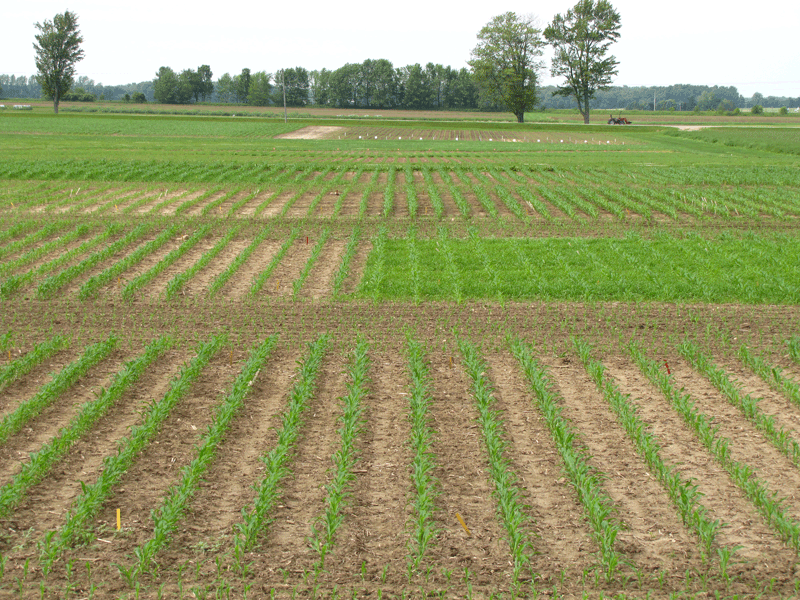Re-plant and stress recovery in corn
RECENT RESEARCH PROVIDES ANSWERS TO COMMON WEED MANAGEMENT CONCERNS
in any given year, as much as 32,000 acres of Ontario corn is re-planted due to poor plant stand establishment. “If a poor stand is not removed prior to replanting, it becomes a weed that can have significant impact on the yield of the replanted corn crop,” says Dr. Clarence Swanton, a professor in the Department of Plant Agriculture at University of Guelph.

Most of these poor stands feature hybrids tolerant to non-selective herbicides such as glyphosate (e.g. Roundup Ready) and glufosinate (e.g. Liberty) and these herbicides are therefore useless in removal of the first poor stand. Swanton has been studying the efficacy of graminicides, a group of herbicides used in soybeans to control emerged volunteer corn and annual grassy weeds with low residual control.
While most graminicides do have a plant-back interval — the optimal time to wait to replant after a chemical is applied — Swanton says this interval is based on the highest registered rate of the herbicide, which is often two to three times higher than that required to control volunteer corn. “We also have preliminary evidence to suggest that corn injury from these graminicides may be enhanced by the presence of soil-applied HPPD inhibiting herbicides such as Callisto or Impact,” he says.
Swanton conducted experiments involving both these factors in 2010 and 2011 at the Elora Research Station on a silt-loam soil with medium fertility. Treatments involved applying five graminicides plus adjuvant at twice the rate recommended to control volunteer corn one day before planting/ three days before emergence. HPPD inhibiting herbicides were applied in some treatments at twice the label rate 12 days before planting. Glyphosate-tolerant corn was planted at a density of 32,000 plants per acre in early May and all plots were kept weed-free with periodic treatment with glyphosate. Grain yield was measured at maturity in early November.
“Our results showed that no injury or yield loss to the new corn plants resulted with graminicide application at twice the rate required to control volunteer corn,” says Swanton. “In 2011, we did see some early seedling corn emergence prior to herbicide application. As a result, we did see some injury (the most in the treatment involving Venture), but no significant yield loss.” He also found that applying the HPPD inhibiting herbicide 12 days before planting at twice the label rate did not cause greater injury. “Results can vary depending on soil type and growing conditions,” Swanton notes, “but spraying with graminicides a day before re-planting after a poor stand appears to be appropriate.”
early weed stress in corn
Another project by Swanton involves weed competition in corn — a situation that occurs when growers are forced to delay the application of post-emergence herbicides. “The presence of weeds can reduce yields by as much as 0.5 to 3.3 bushels per day that application is delayed,” he says. “This yield potential is generally reduced and not recovered, but we wanted to find out if it is possible to recover all or a part of it using nutrients and fungicides. There are a number of solutions being floated out there and we wanted to provide farmers with solid information about whether stress-recovery treatments work.”
At the Elora Research Station in 2010 and 2011, Swanton set up an experiment to determine how different stress-recovery treatments could perhaps boost yield loss due to early weed stress. On a silt-loam soil with medium fertility 45 pounds per acre of nitrogen was broadcast over all plots and incorporated prior to planting. “We used duration of weed competition as the main plot treatments,” he says, “which involved seeding non-vernalized winter wheat immediately prior to corn planting in early May. We used a glyphosate-tolerant corn hybrid at a density of 32,000 plants per acre.” In different treatments, the wheat was killed with 892 grams of active ingredient per acre of Halex on May 25, June 4 and June 17, when corn was at the one-, four-, and six-expanded leaf stages, respectively. Stress-recovery treatments involved applying foliar fungicide, foliar fertilizer, micronutrients and/or soil nitrogen either at planting or side-dress.
Swanton found that in 2010, when weeds were controlled at the four- and six-extended leaf stage grain yields were reduced by five and 19 percent respectively, compared to the no-stress treatment. In 2011, grain yield losses ranged from four to 11 percent. Swanton also found that the response to the stress-recovery treatments was similar in no-stress and stress treatments. “Adding soil nitrogen either at planting or side-dress only gave a small yield benefit compared to all other stress-recovery treatments, averaged across all stress treatments,” he says. “Foliar-applied fungicide, fertilizer and micro-nutrients provided no yield benefit compared to the no-recovery treatment.” These results suggest that farmers who have to delay the application of post-emergence herbicides have little recourse to recover lost yield caused by an absence of early weed control.
These projects received funding in part from Grain Farmers of Ontario and through Growing Forward, a federal-provincial-territorial initiative. The Agricultural Adaptation Council assists in the delivery of several Growing Forward programs in Ontario. •







